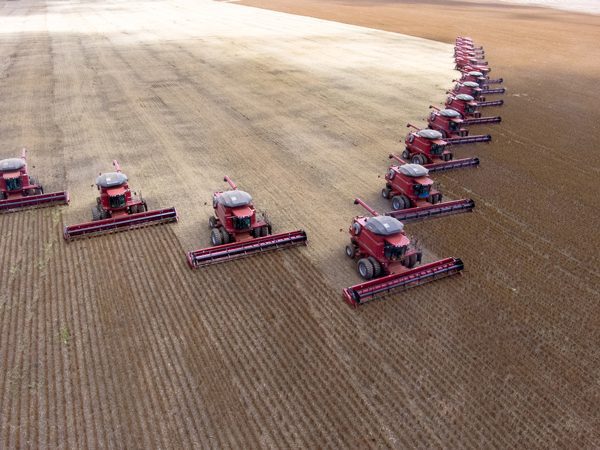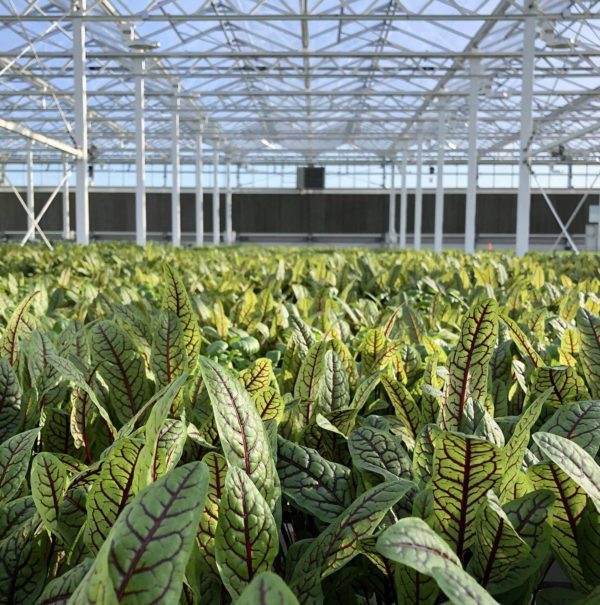We are currently witnessing one of the greatest migrations of all time as an imposing mass of people leaves rural areas believing that they can improve their life by living in cities.
Currently, 55% of the world’s population lives in urban areas and, according to the United Nations, this proportion will reach 68% in 2050.
For example, the population of Mexico City has grown by more than 10 million inhabitants in only forty years! In North America, more than 80% of the population lives in cities, while in Europe, it is estimated that around 75% of the population live in urban areas.
Unfortunately, with unrestrained urban sprawl, the food used to feed city dwellers has to be produced farther and farther away, hundreds or even thousands of kilometers from where it is eaten.

Food has to be transported to cities by plane, train or truck, generating vast quantities of pollutants and greenhouse gases. According to the Worldwatch Institute, the food that makes up a typical American plate must be transported an average of 2,400 kilometers before being eaten.
Also, the FAO estimates that 45% of all fruit and vegetables produced on the globe are lost or thrown away before they can be eaten, in part due to transportation, handling and storage.
Adding to this their fear of GMOs and pesticides, young city dwellers have decided to grow their own food. They have developed unique ways to produce healthy fruits and vegetables, locally, in the heart of cities.
Urban farms on rooftops
Available land is increasingly scarce, and there is a lack of space in cities. It is, therefore, necessary to be particularly creative to practice farming in urban settings, like growing edible plants on rooftops, for example.
The Brooklyn Grange Farm, located in New York, was one of the first suspended urban farms in the United States. The roofs of two buildings in Brooklyn and Queens, with a total area of more than one hectare, support one of the largest urban farms in the world. Nearly 25,000 kilos of vegetables are produced there every year!
Detroit has more than 1,400 urban farms, many of which are located on rooftops, and in Chicago, nearly 400 green roofs are dedicated to the cultivation of edibles. The Chicago Botanical Garden has also set up an urban agriculture training program called Windy City Harvest. Students have the privilege of perfecting their practical learning by growing fruits and vegetables in a garden with an area of nearly 2,000 square meters located on the roof of McCormick Place, the largest congress centre of North America.
In France, there have been more than 200 urban farm startups in recent years. In the city of Nantes, an urban farm called the Agronaute was inaugurated, while in Paris, the largest urban farm in Europe will soon be built on the roofs of the Parc des Expositions located in the 15th borough. Covering an area of 14,000 square meters, this farm will host 20 market gardeners who will produce up to 1,000 kilos of produce per day during summer!
A pioneer in urban agriculture in Canada and North America, the province of Quebec has about 50 commercial urban farms on roofs totalling nearly 300 hectares in cultivation.
Du toit à la table, founded three years ago by François Saint-Pierre, began by growing vegetables at the top of an office building in Quebec City. During the summer of 2019, its fruits and vegetables also grew on the roof of a second building located near Old Quebec. In association with the Dallaire Group, the Du toit à la table team is currently working on the design of the largest roof farm in the world. Construction of this seven-hectare urban farm will be completed in 2022 in the new Chauveau Innovation Space in Loretteville, a neighborhood in Quebec City. It is estimated that up to 30 tonnes of food per hectare could be harvested in this project.

Lufa Farms IMAGE CREDIT: Facebook
Lufa Farms is undoubtedly the most well-known Quebec example of an urban farm on a roof. In this case, however, the cultivation of vegetables is done under greenhouses, installed at the top of three buildings in the greater Montreal area. The heat generated by these buildings is reused for the greenhouses. A fourth commercial rooftop greenhouse is opening this spring, covering 15,000 square metres, the equivalent of two soccer fields.
Another urban farming company called Gotham Greens is growing vegetables in nearly 16,000 square metres of greenhouses on the roofs of four buildings in Chicago and New York.
Indoor urban farms
Rather than growing fruits and vegetables in fields, some urban farmers have developed various ingenious growing techniques to cultivate edible plants inside buildings. In recent years, several indoor urban farm projects have launched in North America and Europe.
The initiators of these urban agriculture projects are renovating old buildings, inside which fruits and vegetables are grown without soil and under artificial lighting. This is particularly the case for Infarm, based in Berlin, Germany, Farm.One, located in the TriBeCa district in the heart of Manhattan, and AeroFarms, based in Newark, New Jersey. About $30 million has been invested in AeroFarms to transform a former steel mill into a state-of-the-art urban farm.
The majority of indoor urban farms grow edible plants without soil, in stacked shelves lit by LED lamps and watered by an aeroponic or hydroponic system. Infarm has developed a flexible modular cultivation system designed to be installed almost anywhere, which has enabled the establishment of around fifty farms located in warehouses, supermarkets and restaurant kitchens. Some other companies, such as Plenty based in California, use a vertical aeroponic system that requires very little space.
The owners of these companies claim that their farming methods use 90 to 95% less water than conventional open-field farming with significantly higher yields! However, although they’re free of pesticides and GMOs, plants grown without soil and microorganisms cannot be certified organic.
Another very original way of growing edible plants in an urban environment, without soil, has been developed recently in North America: growing fruits and vegetables in old shipping containers.
Kimbal Musk, brother of Tesla founder Elon Musk, started a business called Square Roots. The company’s goal is to produce vegetables, GMO-free and pesticide-free, on indoor farms installed in shipping containers in New York. The harvested crops are delivered directly to offices or drop-off points, where members can pick them up. In addition to supplying New Yorkers with healthy food, Square Roots also aims to train people who want to start their business in urban agriculture. Other companies, such as Corner Stalk Farm and Freight Farms, both based in Boston, as well as Agricool, located in Paris, and GrowUp Urban Farms, from London, also produce food in freight containers.
In addition to growing edible plants, GrowUp Urban Farms also practices aquaponics, that is, raising tilapia inside shipping containers. The water from the tanks where the tilapia is raised flows through the columns in which the edible plants are grown so fish droppings can fertilise plants. The fish and vegetables produced are sold to restaurants in the region.
Creating an urban farm on a rooftop
Several buildings with a flat roof can be entirely covered with soil and edible plants. However, the design and construction of an intensive green roof require patience, since in some cases, the supporting structure needs to be strengthened. It is, therefore, preferable to entrust its planning and implementation to specialists.
In addition to the supporting structure, which must be renovated or designed by an engineer, an intensive green roof – entirely covered with soil – generally consists of the following components:
– Insulation
– Waterproofing membrane
– Drainage system
– Growing substrate
– Plants
Extruded polystyrene sheets are used to reduce heat loss from inside the house. The waterproofing membrane can be placed over the insulation material or directly on the supporting structure below. The most common membranes are made of elastomer. It is best to entrust the installation of the waterproofing membrane to experts. If this membrane is not covered with an insulating material, such as polystyrene sheets, protect it from possible perforations by covering it with a geotextile membrane.
On flat roofs, it is essential to install a drainage system to prevent water from stagnating and affecting the survival of plants. The drainage system can simply consist of a layer of coarse gravel. However, to reduce the weight of the installation, one can instead opt for a drainage system made of honeycomb panels specially designed for this purpose. This system directs rainwater to the roof drain or the gutters. The drainage system must be covered with a geotextile membrane to retain the fine particles of the planting substrate while allowing the water to drip. This membrane also prevents plant roots from entering the drainage system and reducing its efficiency.
The substrate in which the plants grow must be light and resistant to compaction while having a good water retention capacity. Earth similar to that used for container culture can be used. To build an intensive green roof for vegetables and fruit shrubs, you need a substrate thickness varying from 20 to 50 cm.
Covering a roof with soil to grow veggies is undoubtedly complicated and expensive. It is much simpler and cheaper to grow edible plants in containers. This reduces the weight that the roof structure has to bear and avoids having to reinforce it at a high cost. Despite this, it is often necessary to have a certified engineer check the maximum load of pots and substrate that can be supported by a roof.
It is preferable to use light and easy-to-transport containers such as those made of textile, like the famous Smart Pots, which are partly made of recycled material. Plastic pots can also be an attractive choice since they are light and affordable. On the other hand, their manufacturing requires petroleum and contributes to global warming.
It is essential not to place the containers in direct contact with the waterproofing membrane of the roof to avoid damaging it or, worse, puncturing it. It is best to place the pots on saucers, recycled rubber pads (usually used to cover stairs during the winter) or even reclaimed wooden pallets. There must be easy access to the roof on which you grow edible plants for easy maintenance.
Opt for large pots, especially for growing tropical vegetables such as tomatoes and cucumbers. On a roof, small containers must be watered every day, sometimes even twice in the same day during a heatwave. Make sure there is a drainage hole at the bottom of each container. Avoid putting gravel at the bottom of the pots; this takes up valuable soil space for plants and dramatically increases the weight of containers.
Use light and rich growing mix with excellent water and nutrient retention capacity. A substrate made of equal part of compost, peat moss and perlite usually gives outstanding results. For an abundant harvest, add mycorrhizae to the substrate and give it to most demanding plants, such as eggplants, cucumbers, peppers and tomatoes. Also provide a few handfuls (approximately 100 ml per plant) of a natural slow-release granular fertiliser, rich in nitrogen and potassium when planting.
Finally, a drip irrigation system is suitable for most edible plants grown in containers. This economic system includes small drippers which supply water very close to the plant roots, avoiding losses by evaporation. These drippers, which can provide 2 to 9 litres of water per hour, are attached to small diameter pipes connected to a central pipe and an outside tap. The whole system can be equipped with an electronic timer. You can also find irrigation pipes perforated with drippers that have copper plates to keep roots and soil from entering. This type of hose is ideal for watering long containers.